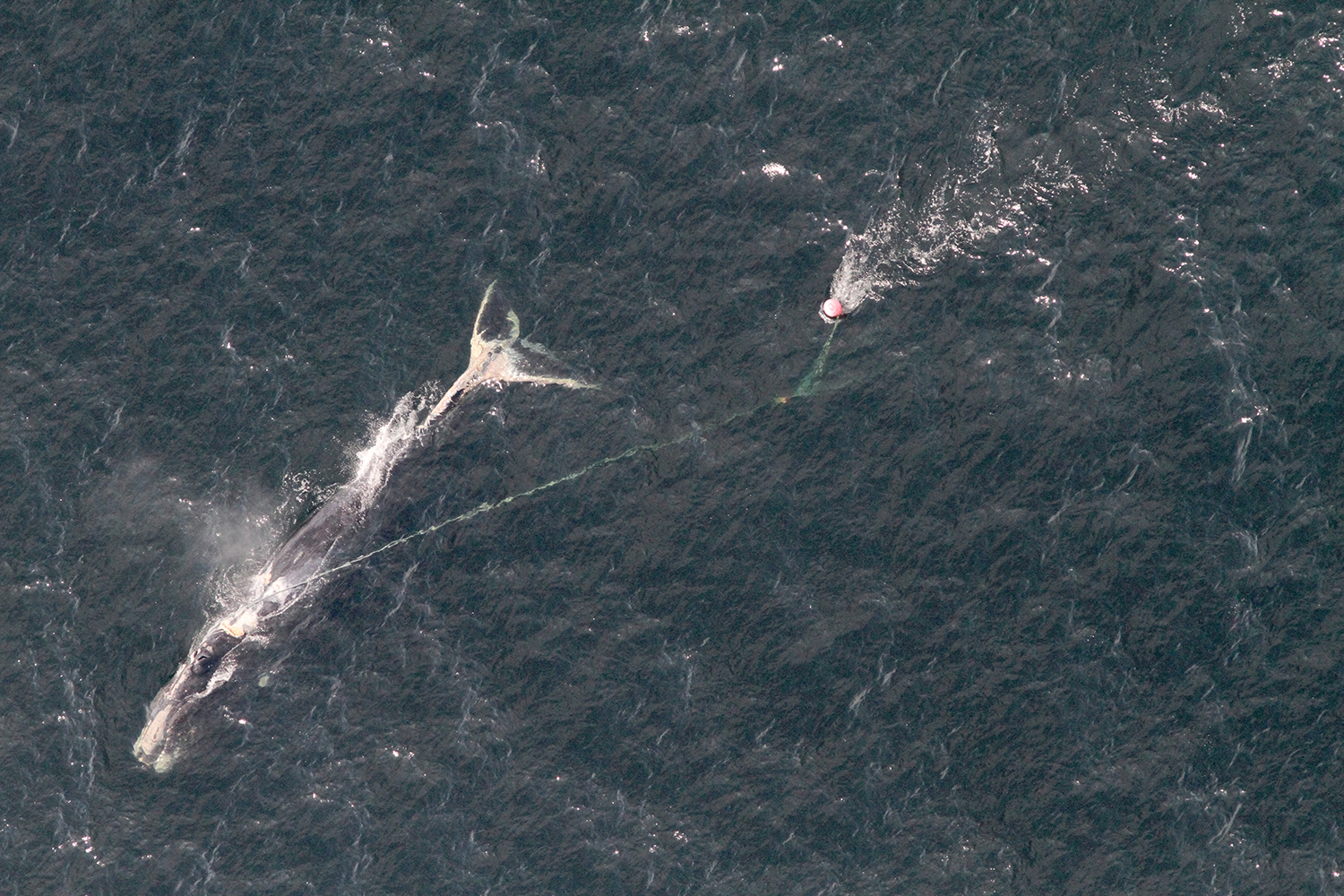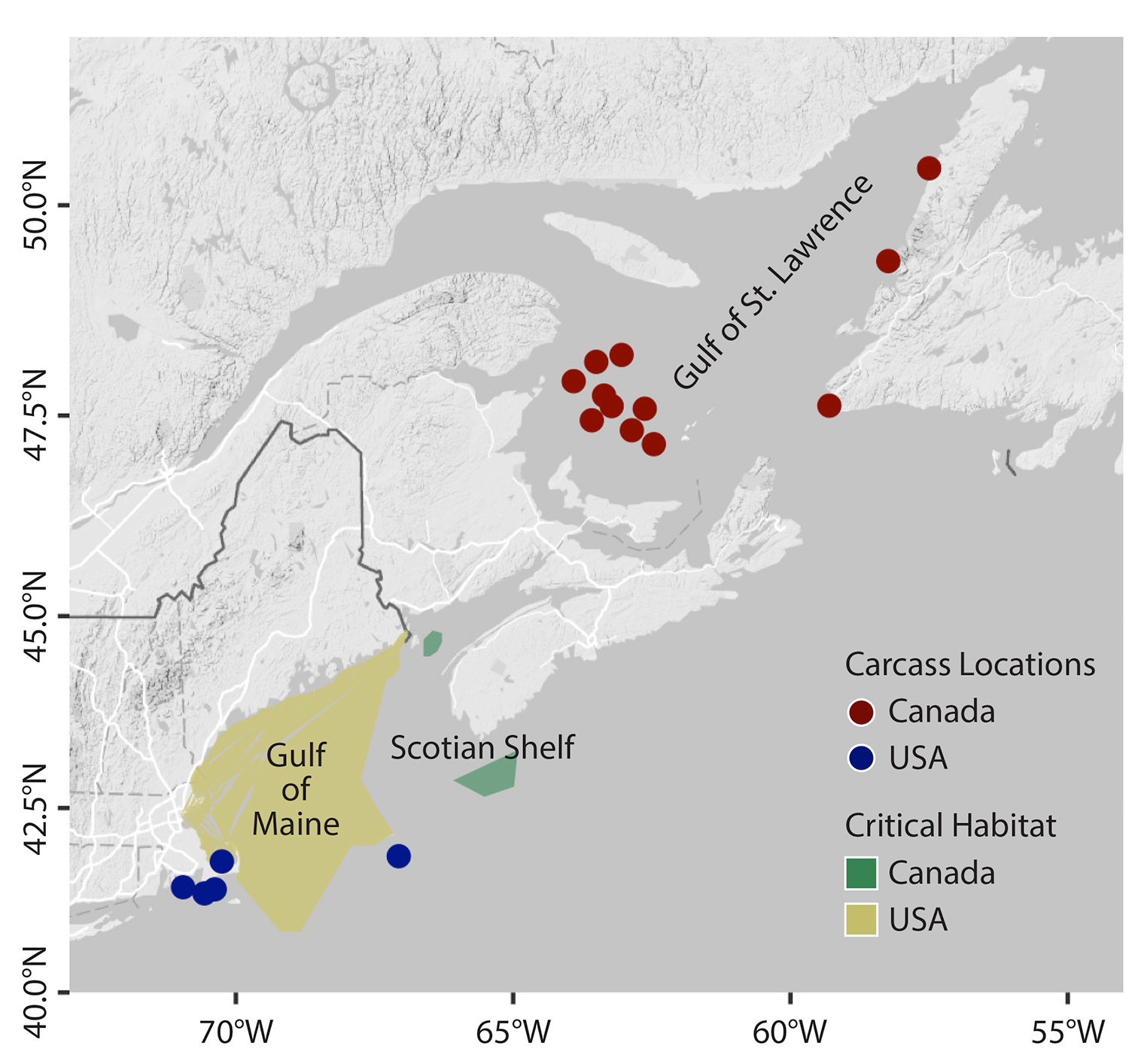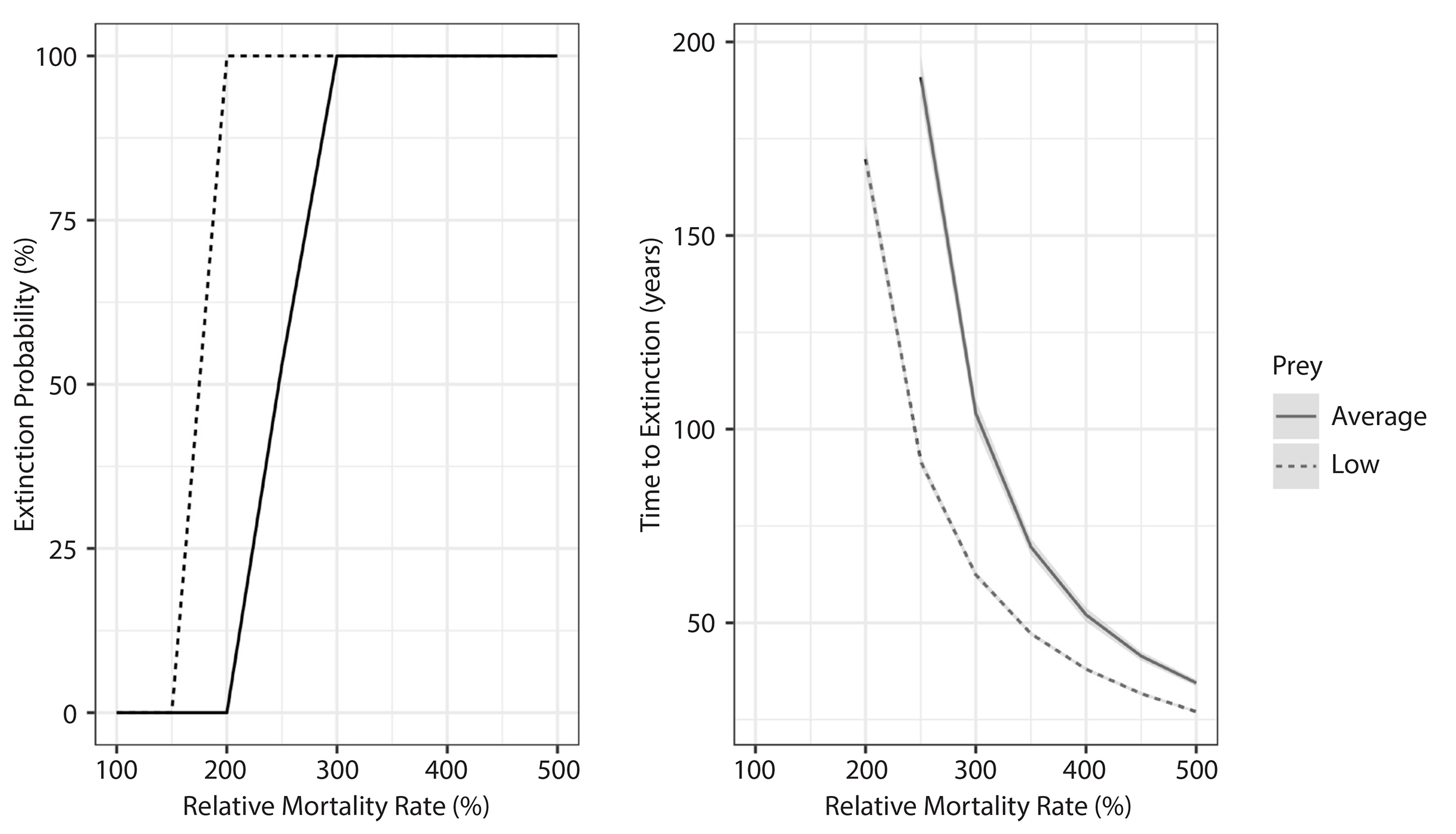Right Whales Threatened by Humans and Climate
The North Atlantic right whale is one of the world’s most endangered cetacean species, with estimates of fewer than 500 animals remaining in the population (Pace et al., 2017; Pettis et al., 2017). Evolving interactions with humans have greatly influenced the history of this species. Following centuries of intense whaling pressure, population growth is now stifled by high mortality rates attributed to ship strikes and entanglement in fishing gear (Kraus et al., 2005, 2016; Figure 1). NOAA Fisheries and Fisheries and Oceans Canada have designated critical habitats throughout the right whale’s traditional range, including portions of the Gulf of Maine and the Scotian Shelf where right whales typically forage for zooplankton (NMFS, 2016; Fisheries and Oceans Canada, 2014; Figure 2). These critical habitats guide the development of protective policies to reduce anthropogenic mortalities, such as vessel speed reductions, vessel rerouting zones, and fishery modifications.

Figure 1. Right whale “Mayport” entangled in fishing gear in the Gulf of St. Lawrence. Image collected on July 19, 2017, under SARA permit DFO-MAR2016-2. Photo credit: NOAA/NEFSC/Peter Duley. > High res figure
|

Figure 2. Map of NOAA Fisheries (yellow) and Fisheries and Oceans Canada (green) right whale northern critical habitat designations and locations of right whale carcasses found in US (blue) and Canadian (red) waters and beaches in 2017. > High res figure
|
While scientists and managers have focused much of their effort on limiting mortalities in these feeding grounds, little consideration has been given to the effect of shifting prey distribution. In the 1990s, declines in the copepod species Calanus finmarchicus, the right whale’s primary source of nutrition, were attributed to a regime shift in the Gulf of Maine ecosystem associated with climate forcing from the Arctic (Greene et al., 2013). These declines drove a shift in right whale habitat use among several important feeding grounds (Hamilton et al., 2007; Patrician and Kenney, 2010; Davies et al., 2015). Low prey abundances reduced calving rates, demonstrating the significant impact prey availability can have on right whale demography (Meyer-Gutbrod et al., 2015; Meyer-Gutbrod and Greene, 2018). Although previous observations of C. finmarchicus declines in the Gulf of Maine have been related to natural climate oscillations and variability in water mass advection (Pershing et al., 2010; Greene et al., 2013; Davies et al., 2014), anthropogenic warming will also play a role in right whale prey availability. Because the Gulf of Maine constitutes the southern edge of suitable habitat for this subarctic copepod species, forecasts of future warming predict significant declines in C. finmarchicus in the Gulf of Maine within this century (Reygondeau and Beaugrand, 2011; Grieve et al., 2017).
Starting in 2012, right whale sightings in several traditional feeding habitats began to decline, causing speculation that a shift in right whale habitat usage was occurring (Pettis et al., 2017). Passive acoustic monitoring efforts indicated a decrease in summertime occupation of the northern Gulf of Maine, supporting this theory (Davis et al., 2017). With fewer animals sighted, scientists and managers were unable to distinguish between a decline in population size and a change in spatial distribution. Using knowledge of summer right whale feeding habitat history to guide exploratory surveys of candidate habitats (e.g., Michaud and Taggart, 2011; Davies et al., 2014), a collaborative effort between the United States and Canada to search for the animals in 2015 revealed an aggregation in the southern Gulf of St. Lawrence (GoSL), well north of the known and protected critical feeding habitats. In 2017, the discovery of 17 right whale carcasses triggered the declaration of an unusual mortality event (Table 1; NOAA Fisheries, 2018). Twelve of these carcasses were located in the GoSL and five in the Gulf of Maine (Figure 2; Daoust et al., 2017). Necropsies of seven of the 12 GoSL carcasses found the causes of death to be blunt force trauma indicative of ship strike in four cases (57%), entanglement in snow crab gear in two cases (29%), and undetermined due to advanced decomposition in one case (14%; Daoust et al., 2017). In addition, five live right whales were seen entangled in snow crab gear in the GoSL (Daoust et al., 2017). When a portion of the right whale population shifted north, likely in search of better feeding grounds, the spatial and temporal mismatch between protective policies and habitat occupancy led to a confirmed loss of over 3% of the estimated population size.
Table 1. Annual counts of confirmed North Atlantic right whale mortalities. Counts are listed by the country where the carcasses were discovered, which is not necessarily the original location of the injury or death of the animal (Pettis and Hamilton, 2010, 2011; Pettis, 2012; NOAA Fisheries, 2018). > High res table

|
Forecasting Changes to the Population
The eventual fate of the North Atlantic right whale depends on both the timeliness and efficacy of new policies, which drive anthropogenic mortality rates, and the future prey environment, which drives reproduction. Prey-dependent demographic modeling studies spanning the period 1980 to 2012 demonstrate that the population has exhibited periods of growth and stasis, but no significant period of decline (Meyer-Gutbrod and Greene, 2018). However, models that include demographic data through 2015 indicate that the species has recently entered a period of decline (Pace et al., 2017). The discovery of 17 carcasses in 2017 constitutes a confirmed annual mortality count unprecedented since the cessation of whaling. Compared to the average of 3.1 confirmed mortalities per year from 1970 to 2009 (van der Hoop et al., 2013), 2017 represented more than a fivefold increase in confirmed mortalities.
Probability of species extinction and time to extinction can be derived from a 1980–2012 prey-dependent capture-recapture model (Meyer-Gutbrod and Greene, 2018) using the relative increase in mortality rates between that time period and 2017. For this analysis, the species is considered functionally extinct when fewer than 10 females remain. Given historical prey conditions, if the 500% relative increase in mortality rates observed in 2017 persists, the population will decline to extinction in just 34 years. Additionally, if reduced C. finmarchicus abundance results in a decrease in reproduction similar to that observed in the late 1990s, which we hypothesize has occurred during the past five years, then extinction could take place in just 27 years (Figure 3). Even with a mortality rate increase of 200%–250%, extinction risk remains high. Under these more moderate increases in mortality, prey availability strongly influences the population’s future (Figure 3).

Figure 3. Probability of right whale population extinction (left) and estimated time until extinction (right) derived from a capture-recapture model given a range of mortality rates and prey scenarios. Mortality rates are relative to those observed historically, where 100% indicates the rates observed from 1980 to 2012 (Meyer-Gutbrod and Greene, 2018) and 500% indicates a fivefold increase from those historical mortality rates. Modeled reproduction rates depend on Calanus finmarchicus anomalies resampled from annually averaged Continuous Plankton Recorder time series 1979–2011 (solid lines) or the lowest five annual anomalies observed in that same period (dashed lines). > High res figure
|
Unfortunately, there have been signals that the right whale prey environment is worsening. The reduced use of most traditional foraging grounds combined with the recent decline in calving rates indicate that the population has been facing prey limitation during the last few years (Pettis et al., 2017). C. finmarchicus abundance has been anomalously low in Gulf of Maine and Scotian Shelf waters since 2011 (Johnson et al., 2017). Concurrent declines in Calanus spp. in the Gulf of St. Lawrence suggest that the whales’ northward range shift may not be a successful adaptation to declines in Gulf of Maine prey (Devine et al., 2017). This decline in prey has been reflected in the low calving rates since 2012 (Pettis et al., 2017). Only five calves were born in 2017, and no newborn calves have been sighted thus far in 2018.
Expanding Protective Policies
These population projections demonstrate the extent of human involvement in the viability of the North Atlantic right whale population. Prior to the distributional shift, vessel speed reductions and rerouting zones in the United States and Canada resulted in a significant reduction in right whale deaths attributed to ship strikes (Vanderlaan and Taggart, 2009; Laist et al., 2014). Fishery modifications have been less successful in reducing mortalities, with increasing entanglement severity over the last three decades, potentially attributable to increasing rope strength (Knowlton et al., 2012, 2016). However, these government and industry efforts should inspire cautious optimism that conservation of this highly endangered species remains within our grasp. In an impressive display of rapid response during the GoSL mortality crisis, policymakers and industry leaders were able to draw upon decades of research and experience to introduce emergency protection measures within weeks. These policies included a massive search for right whales using aerial, vessel, and autonomous vehicle platforms in the GoSL; a mandatory 10-knot speed limit for all large vessels; and snow crab fishery closures (Daoust et al., 2017).
The 2017 GoSL emergency management action was informed by the temporary, near-real-time right whale search effort, but these rapid-response measures were arduous and expensive. We are now challenged to develop a program that combines scientific effort and conservation policy that is sustainable and adaptive. It is essential that future management efforts continue to draw upon previous policy outcomes and scientific best practices while also considering the present and potential future distributional shifts in right whales.
The 2018 plan for protecting right whales in the Gulf of St. Lawrence announced by Fisheries and Oceans Canada includes a number of risk mitigation strategies, notably mandatory speed reductions for vessels >20 m, an early closure of the snow crab fishery, a large fixed closed area where no snow crab or lobster gear is permitted, and dynamic management areas (Fisheries and Oceans Canada, 2018). In addition to these efforts, we recommend the following strategies, some of which are under development:
- Establish a robust and sustainable program for monitoring North Atlantic right whale occupation in the GoSL using a combination of vessel-based, aerial, and passive-acoustic monitoring methods. Monitoring efforts should be balanced to optimize the trade-off between monitoring known aggregation areas and searching for unknown habitats. These long-term data are essential for the creation and assessment of conservation policy.
- Reinstitute the Continuous Plankton Recorder (CPR) program in the Gulf of Maine to monitor prey conditions in the traditional feeding grounds of right whales. Overseen by the Sir Alister Hardy Foundation for Ocean Science, this plankton monitoring program began in 1961 (Jossi and Kane, 2013), but due to funding limitations, samples have not been processed since 2011 and data collection ceased in spring 2017. Plankton data from the CPR survey are critical to predicting right whale reproductive potential and evaluating the likelihood of these feeding grounds being abandoned in any given year.
- Conduct a robust study of the effectiveness of the mandatory dynamic management area strategies for fisheries and shipping implemented in the GoSL in 2018.
- Continue to evaluate and enhance current efforts to minimize the spatial and temporal overlap between snow crab fishery gear and right whales through trap limits, quota limits, and changes to the seasonal timing of the fishery. Consider expanding these policies to other Canadian critical habitats according to observed habitat use.
- Pilot test and implement appropriate fishing gear modifications to reduce risk of entanglements. Options currently under consideration include ropeless fishing and whale release ropes.
- With the help of expanded routine and exploratory monitoring, establish and legislate new critical habitat(s) for right whales in the GoSL.
The GoSL crisis demonstrated that mismatches between localized policy implementation and habitat occupancy can rapidly and severely impact right whale recovery potential. A robust monitoring program forms the backbone of right whale science and policy development. Manned aerial and vessel-based surveys that collect photo-identification data will continue to be essential for population and health assessments. However, acoustic technologies on autonomous gliders and buoys can efficiently and inexpensively identify right whale presence over large areas in near-real time while operating in remote habitats or bad weather (Baumgartner et al., 2013). Extended support of environmental monitoring, including collection of oceanographic and climatic data and ecological monitoring programs such as the CPR survey, can help alert scientists to impending distributional shifts. It should be noted that while recent efforts to update right whale protections focus on the GoSL, continued survey support and progress in fishery modifications remain critical in US waters and other areas of Canada.
The need for expanded monitoring efforts and adaptive management strategies is not unique to right whale conservation. Evidence of impending distributional shifts is mounting for marine top predators whose well-being relies on protective policies (Cheung et al., 2010; Hazen et al., 2013). Lagged policy responses pertaining to commercially exploited species threaten fishery sustainability and disproportionately impact the world’s least developed nations (Allison et al., 2009; Pinsky and Fogarty, 2012). Because not all climate change interactions can be predicted, harvest control rules and conservation policies must be structured dynamically, allowing for rapid expansion following unexpected events. In the long term, effective policies should be expanded globally to encourage management that is proactive instead of just reactive. Under mounting pressure from increased anthropogenic stressors to marine ecosystems, the timely implementation and adaptation of conservation and management policies is critical to the health of the global ocean and its living inhabitants (Greene, 2016). As it has in the past, the future fate of iconic species such as the North Atlantic right whale, and the ecosystem that it depends upon and contributes to, will be determined by these policy decisions.





